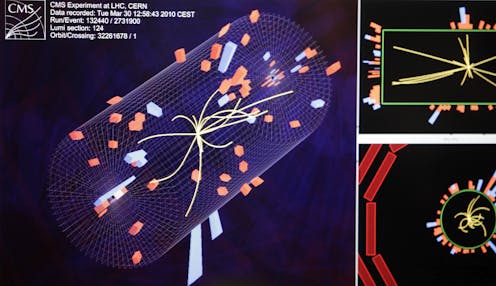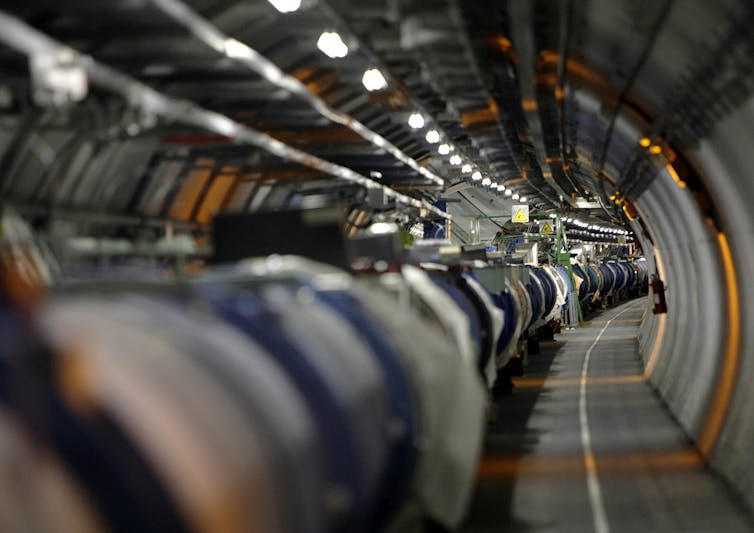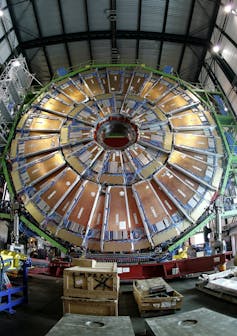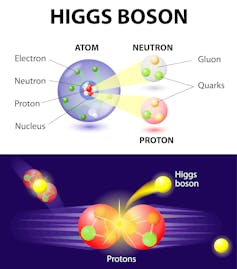Ten years of Large Hadron Collider discoveries are just the start of decoding the universe
The Large Hadron Collider has generated mind-blowing science in the last decade – including the Higgs boson particle. Why is the LHC so important, and how will physicists use it in the years to come?

Ten years! Ten years since the start of operations for the Large Hadron Collider (LHC), one of the most complex machines ever created. The LHC is the world’s largest particle accelerator, buried 100 meters under the French and Swiss countryside with a 17-mile circumference.
On September 10, 2008, protons, the center of a hydrogen atom, were circulated around the LHC accelerator for the first time. However, the excitement was short-lived because on Sept. 22 an incident occurred that damaged more than 50 of the LHC’s more than 6,000 magnets – which are critical for keeping the protons traveling on their circular path. Repairs took more than a year, but in March 2010 the LHC began colliding protons. The LHC is the crown jewel of CERN, the European particle physics laboratory that was founded after World War II as a way to reunite and rebuild science in war-torn Europe. Now scientists from six continents and 100 countries conduct experiments there.
You might be wondering what the LHC does and why it is a big deal. Great questions. The LHC collides two beams of protons together at the highest energies ever achieved in a laboratory. Six experiments located around the 17-mile ring study the results of these collisions with massive detectors built in underground caverns. That’s the what, but why? The goal is to understand the nature of the most basic building blocks of universe and how they interact with each other. This is fundamental science at its most basic.

The LHC has not disappointed. One of the discoveries made with the LHC includes the long sought-after Higgs boson, predicted in 1964 by scientists working to combine theories of two of the fundamental forces of nature.
I work on one of the six LHC experiments – the Compact Muon Solenoid experiment designed to discover the Higgs boson and search for signs of previously unknown particles or forces. My institution, Florida State University, joined the Compact Muon Solenoid collaboration in 1994 when I was a young graduate student at another school working on a different experiment at a different laboratory. Planning for the LHC dates back to 1984. The LHC was hard to build and expensive – 10 billion euros – and took 24 years to come to fruition. Now we are celebrating 10 years since the LHC began operating.

Discoveries from the LHC
The most significant discovery to come from the LHC so far is the discovery of the Higgs boson on July 4, 2012. The announcement was made at CERN and captivated a worldwide audience. In fact, my wife and I watched it via webcast on our big screen TV in our living room. Since the announcement was at 3 a.m. Florida time, we went for pancakes at IHOP to celebrate afterwards.
The Higgs boson was the last remaining piece of what we call the standard model of particle physics. This theory covers all of the known fundamental particles – 17 of them – and three of the four forces through which they interact, although gravity is not yet included. The standard model is an incredibly well-tested theory. Two of the six scientists who developed the part of the standard model that predicts the Higgs boson won the Nobel Prize in 2013.

I am often asked, why do we continue to run experiments, smashing together protons, if we’ve already discovered the Higgs boson? Aren’t we done? Well, there is still lots to be understood. There are a number of questions that the standard model does not answer. For example, studies of galaxies and other large-scale structures in the universe indicate that there is a lot more matter out there than we observe. We call this dark matter since we can’t see it. The most common explanation to date is that dark matter is made of an unknown particle. Physicists hope that the LHC may be able to produce this mystery particle and study it. That would be an amazing discovery.
Just last week, the ATLAS and Compact Muon Solenoid collaborations announced the first observation of the Higgs boson decaying, or breaking apart, into bottom quarks. The Higgs boson decays in many different ways – some rare, some common. The standard model makes predictions about how often each type of decay happens. To fully test the model, we need to observe all of the predicted decays. Our recent observation is in agreement with the standard model – another success.
More questions, more answers to come
There are lots of other puzzles in the universe and we may require new theories of physics to explain such phenomena – such as matter/anti-matter asymmetry to explain why the universe has more matter than anti-matter, or the hierarchy problem to understand why gravity is so much weaker than the other forces.

But for me, the quest for new, unexplained data is important because every time that physicists think we have it all figured out, nature provides a surprise that leads to a deeper understanding of our world.
The LHC continues to test the standard model of particle physics. Scientists love when theory matches data. But we usually learn more when they don’t. This means we don’t fully understand what is happening. And that, for many of us, is the future goal of the LHC: to discover evidence of something we don’t understand. There are thousands of theories that predict new physics that we have not observed. Which are right? We need a discovery to learn if any are correct.
CERN plans to continue LHC operations for a long time. We are planning upgrades to the accelerator and detectors to allow it to run through 2035. It is not clear who will retire first, me or the LHC. Ten years ago, we anxiously awaited the first beams of protons. Now we are busy studying a wealth of data and hope for a surprise that leads us down a new path. Here’s to looking forward to the next 20 years.
Todd Adams receives funding from US Department of Energy.
Read These Next
What’s at stake in Trump’s executive order aiming to curb state-level AI regulation
In the absence of comprehensive federal AI regulation, states have stepped in. The Trump administration,…
The Bible says little about Jesus’ childhood – but that didn’t stop medieval Christians from enjoyin
Legends about Jesus’ early years that circulated in medieval Europe often drew on apocryphal texts.
Data centers need electricity fast, but utilities need years to build power plants – who should pay?
How many data centers will be built – and how much electricity they’ll need – is uncertain. Being…





